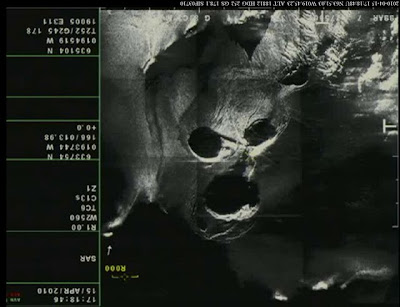Nordic Volcanological Center brings us this face-detector-tripping radar image:

For more pictures of the eruption:
Volcanic lightning photos by Marco Fulle
NASA feature on Eyjafjallajökull
Boston.com pictorial
Yahoo! editor's picks gallery on Flickr
A quick guide to volcanoes (I read a geology intro book earlier this year! Go go superficial knowledge!):
Basaltic iron-rich lava flows smoothly and makes pahoehoe and aa flows and pretty pictures. Basaltic (a.k.a. mafic) and ultramafic lavas come from the mantle, and so tend to happen at hot spots (plume of hot rock rising through the mantle and punching through the crust) and divergence zones (two plates drifting apart, the gap getting filled by outflow from the mantle).
Felsic silica-rich lava doesn't really flow, so it tends to clog up magma vents and trap gases. Clogging up a mountaintop tends to build pressure under it. Once the pressure builds up enough, the mountaintop blows up in a massive explosion and releases roiling pyroclastic clouds. Felsic lava comes from subduction zones where seafloor is pushing under the continental plate. At a depth of a forty km or so, the water in the seafloor rocks starts melting the surrounding mantle and the resulting magma rises up through the continental crust, forming a volcanic arc.
See ArsTechnica's article for an explanation why the Icelandic diverge zone volcano (the place sits on top of the Atlantic mid-ocean ridge) still blew up in a felsic fashion.
See the Eruptions blog for more info.
No comments:
Post a Comment